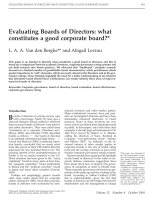Recognizing a Good Argument
Bạn đang xem bản rút gọn của tài liệu. Xem và tải ngay bản đầy đủ của tài liệu tại đây (104.85 KB, 10 trang )
Y
ou got laid off from your job two months ago. You’ve been looking for another job but haven’t had
much luck. But the company you interviewed with yesterday just made you an offer. The pay isn’t
that good, but you’re thinking about taking the job anyway; you need the money. Your friend, how-
ever, tells you not to take it: “The pay is lousy, the hours are terrible, and there are no benefits,” he says. “Don’t
do it.” Should you listen to your friend? Has he made a good argument? How can you tell?
You already know what a deductive argument is. You know how to separate the conclusion from the evidence.
And you know how to evaluate the evidence. These are essential steps in analyzing a deductive argument. But in
order to determine the overall strength of an argument, there are several other criteria to take into consideration.
Specifically, in a good deductive argument:
■
The conclusion and premises are clear and complete.
■
The conclusion and premises are free of excessive subtle persuasion.
■
The premises are credible and reasonable.
■
The premises are sufficient and substantive.
■
The argument considers the other side.
LESSON
Recognizing a
Good Argument
LESSON SUMMARY
There are many components of a good argument—one that is con-
vincing for good reason. This lesson will show you how to recognize
and make a strong deductive argument.
9
65
You should already be familiar with the first three
criteria, so we’ll just take a moment to review them
before we address the last two.
Clear and Complete
In Lesson 5, “Partial Claims and Half-Truths,” you
learned how to recognize hidden agendas. In order for
a deductive argument to carry weight, its conclusion
must be clear and complete; there should be no doubt
about the claim being made. The same goes for the
premises; if a comparison isn’t fair or if what is being
compared isn’t clear, that claim cannot be valid. Evi-
dence can’t be reasonable if it is incomplete.
Free of Excessive Subtle
Persuasion
In Lesson 6, “What’s in a Word?” you learned about
euphemisms, dysphemisms, and biased questions.
These subtle persuasion techniques are indeed manip-
ulative, but they’re not the ultimate sin when it comes
to arguments. It’s natural for people to choose words
that will have a certain impact on their listeners. It’s
natural, for example, for the government to use the
phrase “military campaign” if they don’t want to raise
protests about going to war. In other words, the occa-
sional euphemism, dysphemism, or mildly biased
question can be forgiven. But if an argument is loaded
with these persuasive techniques, you should analyze it
carefully. Generally, arguments that are laden with
euphemisms, dysphemisms, and biased questions are
this way because they lack reasonable and credible
evidence. In other words, the arguer may be trying to
persuade you with language rather than reason
because he or she lacks evidence. Excessive use of sub-
tle persuasion can also indicate that the arguer is
biased about the issue.
Credible and Reasonable
Premises
As discussed in the previous lesson, the two criteria for
good evidence are credibility and reasonableness.Evi-
dence is credible when it is free of bias and when the
sources have a respectable level of expertise. Evidence
is reasonable when it is logical, drawn from evidence or
common sense.
Sufficient and Substantive
Premises
You ask a coworker about the restaurant that recently
opened down the street. He tells you, “The Hot Tamale
Café? Don’t eat there. The service is lousy.”
Has he given you a good argument? Well, the
conclusion, “Don’t eat there,” is clear and complete. The
premise that supports the conclusion, “The service is
lousy,” is also clear and complete. The premise and
conclusion are free from subtle persuasion. The prem-
ise is reasonable, and we don’t have any reason to
doubt credibility—he’s given good recommendations
about places to eat before. But is this a good argument?
Not really.
Though all of the other criteria check out, this
argument has a very important weakness: It simply
doesn’t offer enough evidence. Not enough reasons are
given to accept the conclusion. So, the service is lousy.
But maybe the food, the ambiance, and the prices are
excellent. When there are so many other reasons for
going to a restaurant, just one premise to support that
conclusion is not enough.
Here’s a much better argument. What makes it
better is the number of premises offered to support the
conclusion. Some premises are separate support, and
some are offered to support other premises (chains of
support).
–
RECOGNIZING A GOOD ARGUMENT
–
66
Don’t eat at that restaurant. The service is lousy.
They messed up our orders and we had to wait 15
minutes even though there were empty tables. The
food is overpriced, too. A plain hamburger is $12.50!
The place is dirty—we had to wipe our table down
twice with napkins, and I saw a dead cockroach in
the corner. And there is no décor to speak of—just
bright blue walls and a poster of Hawaii in the cor-
ner, even though it’s a Mexican restaurant.
Now this restaurant sounds like a place to avoid,
doesn’t it? What’s good about this argument is not only
that it offers several distinct premises that separately
support the conclusion (major premises), but it also
offers support (minor premises) for each of those
premises. Each major premise is followed by a specific
detail that supports that premise. Here’s how this
argument maps out:
Conclusion: Don’t eat at that restaurant.
Major premise: The service is lousy.
Minor premise: They messed up our orders.
Minor premise: We had to wait 15 minutes even
though there were empty tables.
Major premise: The food is overpriced.
Minor premise: A plain hamburger is $12.50!
Major premise: The place is dirty.
Minor premise: We had to wipe our table down
twice with napkins .
Minor premise: I saw a dead cockroach in the
corner.
Major premise: There is no décor.
Minor premise: just bright blue walls and a
poster of Hawaii in the corner,
even though it’s a Mexican
restaurant.
Practice
1. Take the following argument and make it sub-
stantial. Provide more evidence by adding major
and minor supporting premises:
Public school students should wear uniforms just
like private school students do. Uniforms will create
a stronger sense of community.
Stronger argument:
Answer
Your answer will vary depending upon what premises
you chose to support this argument. At any rate, your
argument should be significantly longer than the first
version. Here’s one revision that provides several major
and minor premises to support the conclusion. The
major premises are in bold.
Public school students should wear uniforms just
like private school students do. For one thing, uni-
forms will create a stronger sense of community.
It’s important for children to feel like they belong,
and uniforms are a powerful physical and psycho-
logical way to create that sense of belonging. Uni-
forms also improve discipline. According to the
Department of Education, private schools across
the country have fewer discipline problems than
public schools, and the handful of public schools
that have experimented with uniforms have found
–
RECOGNIZING A GOOD ARGUMENT
–
67
that their discipline problems decreased sharply.
Furthermore, uniforms can help increase the self-
esteem of children from low-income families. If
everyone wears the same clothes, they don’t have to
come to school ashamed of their hand-me-downs or
second-hand clothing.
Considering the Other Side
At the beginning of this lesson, your friend tried to talk
you out of taking that job offer. Did he provide a good
argument based on the criteria we’ve discussed so far?
Here’s his argument again to refresh your memory:
“The pay is lousy, the hours are terrible, and there
are no benefits,” he says. “Don’t do it.”
Well, his argument is reasonable, credible, free of
subtle persuasion, and he offers three different rea-
sons, though they could be supported with specific
details (minor premises). Still, this argument lacks one
criterion of a good argument; it does not consider
counterarguments.
Counterarguments are those arguments that
might be offered by someone arguing for the other
side. That is, if you are arguing that it’s better to live in
the city than in the country, you need to keep in mind
what someone arguing that living in the country is
better than living in the city might think. By consid-
ering counterarguments, you show your critical
thinking skills—whatever your opinion, you have
considered all sides of the issue. And this helps
demonstrate your credibility, too; it shows that you’ve
done your homework, that you obviously know
something about the issue.
For example, when you hear your friend’s argu-
ment, what thoughts might go through your mind?
You might come up with the following reasons to take
the job rather than reject it:
■
You really need the money.
■
You can advance quickly.
■
You’ll have benefits after six months.
■
You can switch to a different shift after six months.
■
It’s a lot closer to home than your previous job.
If your friend really wants to convince you not to take
the job, he’ll not only support his conclusion with cred-
ible, reasonable, and ample evidence, he’ll also show
that he knows why you might want to say yes—and why
his reasons for saying no are better.
One way to help you develop a better argument is
to play devil’s advocate. When you’re getting ready to
make an argument, write down your conclusion and
your premises, and then do the same for the opposite
position. You might want to pretend you are in court
and you are both the prosecution and the defense. This
will help you anticipate what the other side will say and
therefore you can come up with a premise to counter
that argument. Here’s how your friend might revise his
argument if he considered the other side:
Don’t take that job. I know you really need the
money, but the pay is lousy. It’s a full three dollars
less per hour than your last job. You can probably
move through the ranks quickly, but because you’d
be starting at a lower pay scale, you’d have to take
several steps just to get back up to your old salary.
And you have to wait six months before you can
switch shifts and get benefits. What if something
happens in the meantime? True, you’ll save time
and gas because it’s closer, but is that extra thirty
minutes a day worth it?
Notice two things that your friend does here. First, he
systematically and carefully acknowledges each of your
concerns. Second, he counters each of those concerns
with a reasonable premise. Furthermore, he improved
his argument by adding specific minor premises, like
the fact that the pay is three dollars less per hour.
Now it’s your turn.
–
RECOGNIZING A GOOD ARGUMENT
–
68
Practice
The school uniform argument is reprinted below. Play
devil’s advocate and make a list of counterarguments.
Then rewrite the argument to make it stronger.
Public school students should wear uniforms just
like private school students do. For one thing, uni-
forms will create a stronger sense of community.
It’s important for children to feel like they belong,
and uniforms are a powerful physical and psycho-
logical way to create that sense of belonging. Uni-
forms also improve discipline. According to the
Department of Education, private schools across
the country have fewer discipline problems than
public schools, and the handful of public schools
that have experimented with uniforms have found
that their discipline problems decreased sharply.
Furthermore, uniforms can help increase the self-
esteem of children from low-income families.If
everyone wears the same clothes, they don’t have to
come to school ashamed of their hand-me-downs or
second-hand clothing.
2. Counterarguments:
3. Revised argument:
Answers
Your counterarguments might look something like the
following:
a. Uniforms won’t create a stronger sense
of community; they’ll create a culture of
conformity.
b. Uniforms alone won’t decrease discipline
problems. The problem goes deeper than that.
c. Students from low-income families will still
have less expensive shoes, coats, etc. Uniforms
alone can’t hide their socioeconomic status.
Your revised argument depends upon your coun-
terarguments. Here’s how the counterarguments might
be incorporated. The sentences that address counter-
arguments are in bold.
Public school students should wear uniforms just
like private school students do. For one thing, uni-
forms will create a stronger sense of community. It’s
important for children to feel like they belong, and
uniforms are a powerful physical and psychological
way to create that sense of belonging. While some
worry that uniforms encourage conformity, a
sense of belonging helps give students the self-
esteem they need to find their individuality. Uni-
forms also improve discipline. According to the
Department of Education, private schools across the
country have fewer discipline problems than public
schools, and the handful of public schools that have
experimented with uniforms have found that their
discipline problems decreased sharply. This demon-
strates that uniforms alone can have a profound
affect on discipline. Furthermore, uniforms can
help increase the self-esteem of children from low-
income families. If everyone wears the same clothes,
they don’t have to come to school ashamed of their
–
RECOGNIZING A GOOD ARGUMENT
–
69









